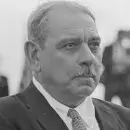
Luis Muñoz Marín
Luis Muñoz Marín was a journalist, politician, statesman, and the first elected governor of Puerto Rico, known as the “Architect of the Puerto Rico Commonwealth.” As governor for over sixteen years, he headed an administration that worked on profound economic, political, and social reforms that were praised internationally by politicians, statesmen, political scientists, and economists of the time.
Born in Old San Juan less than a year before Puerto Rico was ceded by Spain to the United States, he was educated at Georgetown University Law Center (1915) but dropped out to pursue writing poetry. In 1926, Muñoz Marín returned to Puerto Rico and began editing the newspaper La Democracia. In 1932, he was elected to the Puerto Rican Senate and began advocating for independence from the United States, which caused him to be expelled from the Liberal Party. Muñoz Marín went on to found his own party in 1938, called the Popular Democratic Party, which focused on political rights for the rural poor. The party gained power in 1940, allowing Muñoz Marín to serve as president of the Senate from 1940 until 1948. During this time, he began advocating for cooperation with the United States rather than independence.
In 1948, Congress granted Puerto Rico the right to elect its own governor. Muñoz Marín was elected with substantial majorities to four consecutive terms, from 1949 to 1965. His main achievement was helping to change Puerto Rico’s status from a U.S. territory to a commonwealth with a greater degree of self-governance. His tenure as governor was also characterized by significant initiatives like Operation Bootstrap, which transformed Puerto Rico’s economy from agriculture to manufacturing and tourism.